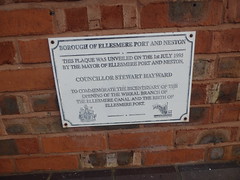Commemorated on 1 plaque
This plaque was unveiled on the 1st July 1995 by the Mayor of Ellesmere Port and Nelson, Councillor Stewart Hayward to commemorate the bicentenary of the opening of the Wirral Branch of the Ellesmere Canal and the birth of Ellesmere Port.
National Waterways Museum - Shropshire Union Canal, Ellesmere Port, United Kingdom where it opening of the Wirral branch (1795)

